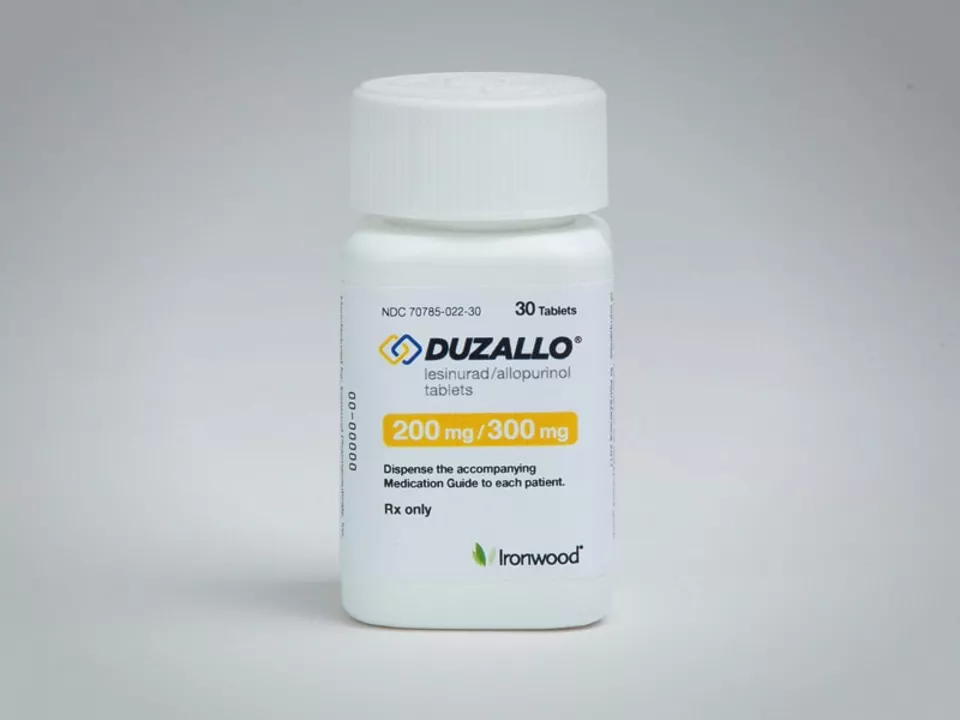Understanding Gout and the Role of Allopurinol
Before diving into the alternatives, it's essential to understand what gout is and how Allopurinol works to treat it. Gout is a form of inflammatory arthritis that occurs when uric acid levels in the blood become too high, leading to the formation of urate crystals in the joints. This results in severe pain, redness, and swelling. Allopurinol is a medication commonly prescribed to manage gout, as it lowers uric acid levels in the blood by inhibiting an enzyme called xanthine oxidase.
However, some individuals may experience side effects or may not be able to tolerate Allopurinol for various reasons. In such cases, it's crucial to explore alternative gout treatment options to manage the condition effectively. In this article, we will discuss six different options to consider as alternatives to Allopurinol.
1. Febuxostat: A Different Approach to Uric Acid Reduction
Febuxostat is another medication that works similarly to Allopurinol by inhibiting the xanthine oxidase enzyme. However, it has a different chemical structure, which may make it a suitable alternative for those who cannot tolerate Allopurinol. Studies have shown that Febuxostat can be more effective at reducing uric acid levels than Allopurinol, making it a viable option for managing gout.
It's essential to note that, like Allopurinol, Febuxostat may cause side effects such as liver function abnormalities or an increased risk of cardiovascular events. Always consult with your healthcare provider before starting any new medication.
2. Probenecid: Assisting the Kidneys in Uric Acid Removal
Probenecid is another medication used to treat gout, but it works differently than Allopurinol and Febuxostat. Instead of inhibiting xanthine oxidase, Probenecid helps the kidneys excrete uric acid more efficiently by blocking the reabsorption of uric acid in the kidneys. This results in lower uric acid levels in the blood and can help prevent gout attacks.
Probenecid may not be suitable for individuals with kidney problems, as it relies on proper kidney function to work effectively. Additionally, Probenecid may interact with other medications, so it's crucial to discuss your current medications with your healthcare provider before starting treatment.
3. Pegloticase: A Biologic Option for Gout Management
Pegloticase is a biologic medication used to treat severe or refractory gout, meaning it is reserved for cases where other treatment options have proven ineffective. Pegloticase works by breaking down uric acid in the blood into a more soluble substance called allantoin, which is then more easily excreted through the kidneys.
Due to its potential side effects, such as severe allergic reactions and the risk of developing antibodies against the medication, Pegloticase is typically reserved for patients who have not responded well to other gout treatments. It's essential to closely monitor your condition and follow your healthcare provider's recommendations when using this medication.
4. Colchicine: Addressing Gout Inflammation
Colchicine is a medication that has been used for centuries to treat gout. It works by reducing inflammation caused by urate crystals in the joints. While it does not lower uric acid levels like Allopurinol, it can be effective in preventing and treating acute gout attacks.
Side effects of Colchicine may include gastrointestinal issues such as nausea, vomiting, and diarrhea. It's essential to take Colchicine as prescribed by your healthcare provider and report any side effects you may experience.
5. Nonsteroidal Anti-Inflammatory Drugs (NSAIDs)
Nonsteroidal anti-inflammatory drugs (NSAIDs) such as ibuprofen, naproxen, and indomethacin are commonly used to treat the pain and inflammation associated with gout attacks. While they do not reduce uric acid levels, they can provide relief during an acute gout flare.
It's important to note that long-term use of NSAIDs may cause side effects such as gastrointestinal bleeding, kidney damage, or increased risk of cardiovascular events. Always follow your healthcare provider's recommendations and use NSAIDs as directed for gout management.
6. Lifestyle Changes and Natural Remedies
In addition to medications, lifestyle changes and natural remedies can help manage gout and reduce the frequency of attacks. Some strategies include maintaining a healthy weight, staying well-hydrated, limiting alcohol intake, and avoiding foods high in purines, such as red meat, seafood, and organ meats.
Natural remedies such as cherries or cherry juice, apple cider vinegar, and supplements like vitamin C or celery seed extract may also help reduce uric acid levels and inflammation. However, it's essential to discuss these options with your healthcare provider before incorporating them into your gout management plan.
In conclusion, there are various Allopurinol alternatives available for managing gout, ranging from different medications to lifestyle changes and natural remedies. It's crucial to work closely with your healthcare provider to find the best treatment plan tailored to your specific needs and health conditions.







17 Comments
Naomi Shimberg
It is imperative to consider that, despite the laudable intent behind febuxostat, its pharmacodynamic profile may not universally supersede that of allopurinol; the heightened risk of cardiovascular events, as documented in several meta‑analyses, warrants meticulous patient selection, particularly among individuals with pre‑existing cardiac conditions. Moreover, the regulatory discourse surrounding its approval underscores a nuanced appraisal of benefit versus risk, rather than an unequivocal endorsement.
kenny lastimosa
Reflecting on the spectrum of therapeutic avenues, one might perceive the quest for alternative agents as a philosophical exercise in balancing efficacy with tolerability, recognizing that each pharmacologic pathway presents its own metaphysical trade‑offs.
Heather ehlschide
For those seeking practical guidance, probenecid offers a renal‑centric mechanism that can be particularly beneficial when kidney function is uncompromised; however, monitoring for drug interactions remains essential, especially with concomitant antivirals or NSAIDs.
Kajal Gupta
Hey folks! 🌟 If you’re tired of the usual meds, give colchicine a try for those nasty flare‑ups. It’s been around forever and can knock down inflammation in a snap, just watch out for the stomach vibes.
Zachary Blackwell
But don’t forget that the pharmaceutical giants push febuxostat and pegloticase like a secret agenda, steering patients toward pricey biologies while downplaying cheap natural alternatives; the whole system is rigged to keep us dependent.
prithi mallick
Stay hopeful; every gout warrior can find a path that fits. Even if one drug feels rough, there’s always another door – keep talking to your doc, listen to your body, and never give up.
Michaela Dixon
When exploring the maze of gout therapeutics, it becomes clear that each option carries its own constellation of mechanisms, side‑effects, and lifestyle implications and that a patient‑centred approach must weave together these threads into a cohesive tapestry of care the first line of defense often begins with drugs that directly lower serum uric acid levels such as allopurinol and febuxostat which act by inhibiting xanthine oxidase thereby reducing the production of uric acid however the choice between them can hinge upon factors like renal function cardiovascular risk profile and even genetic polymorphisms related to drug metabolism the second tier includes uricosuric agents like probenecid that enhance renal excretion of uric acid but their efficacy is contingent upon adequate kidney function and they can interact with a variety of other medications the third category brings us to biologics such as pegloticase which, while powerful in breaking down existing uric acid, carries a risk of immunogenicity and infusion reactions and thus is reserved for refractory cases; the logistical demands of biweekly infusions add another layer of complexity the fourth avenue is the age‑old anti‑inflammatory colchicine which, despite not lowering uric acid, provides rapid relief from crystal‑induced inflammation and is especially useful during acute attacks though gastrointestinal side‑effects may limit its tolerability the fifth route comprises NSAIDs like ibuprofen, naproxen or indomethacin that can quell pain and swelling in the short term but raise concerns about gastrointestinal bleeding, renal injury and cardiovascular events with prolonged use finally, lifestyle and dietary modifications act as a foundational pillar; maintaining optimal hydration, reducing purine‑rich foods, moderating alcohol intake and achieving a healthy body mass index can collectively diminish uric acid production and improve overall outcomes all these options underscore the necessity of a personalized regimen that aligns with the patient’s comorbidities, preferences and risk tolerance and reminds us that gout management is as much an art as it is a science
Dan Danuts
Keep pushing forward, you got this!
Dante Russello
In addition to pharmacotherapy, consider regular monitoring of serum uric acid levels, adherence to dosing schedules, and periodic assessment of renal and hepatic function, all of which can significantly influence treatment efficacy and safety; also, discuss with your provider the possibility of combining low‑dose colchicine with a urate‑lowering agent to mitigate flare frequency.
James Gray
Yo, just try cuttin down on red meat and beer, it helps big time.
Scott Ring
From a cultural standpoint, many Asian cuisines naturally incorporate low‑purine foods, which can be an easy transition for those looking to adjust their diet without feeling deprived.
Shubhi Sahni
Remember, consistency is key: schedule regular check‑ups, keep a gout diary, and stay diligent with hydration; these habits, combined with appropriate medication, often lead to the best outcomes.
Danielle St. Marie
Honestly, most of these alternatives are just over‑hyped – stick to the proven stuff! 😒
keerthi yeligay
Alternative therapies can work, but they need proper medical oversight.
Peter Richmond
In summary, a tailored combination of medication, diet, and regular monitoring often yields the most sustainable gout control.
Bonnie Lin
Pick the right mix and stay consistent.
sara fanisha
You've got plenty of options – trust the process and keep a positive outlook!